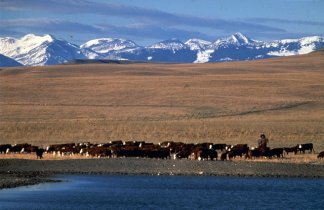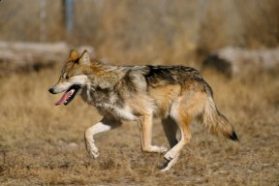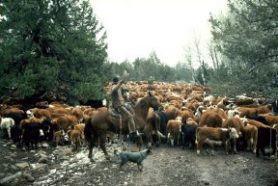The wolf and the cow
Can livestock and predators share the same land?
Share this:
- Share via email (Opens in new window) Email
- Click to share on Facebook (Opens in new window) Facebook
- Click to share on X (Opens in new window) X
- Click to share on Pinterest (Opens in new window) Pinterest
- Click to share on Reddit (Opens in new window) Reddit
- Share to Google Classroom (Opens in new window) Google Classroom
- Click to print (Opens in new window) Print
By Emily Sohn
A gray wolf prowls the underbrush. It stops for a moment and raises its head. It looks about alertly. It bares its sharp teeth. Its golden eyes glint in the sunlight.
 |
|
A gray wolf.
|
| Gary Kramer, U.S. Fish and Wildlife Service |
Like lions, tigers, eagles, and sharks, the wolf is a predator. It hunts other animals for food. Some people admire the wolf. Others fear it.
Visitors to zoos or animal parks tend to think that wolves, tigers, and other predators are pretty cool. Ranchers who are trying to protect their cattle have a very different reaction. They tend to like only one kind of predator: the dead kind.
Will Holder used to have the same reaction that most ranchers do. As a kid growing up on a ranch in Arizona, Holder learned early on that wolves, coyotes, and mountain lions were supposed to be evil, ever poised to pounce on a herd of innocently grazing cattle.
“What you did when you saw coyotes run across the road was to jump out of the pickup and shoot them,” Holder says.
As the years passed, Holder started to wonder if killing predators actually helped protect livestock. He asked his parents when a coyote had ever killed a ranch animal. His mother could remember just one incident, which had occurred during a drought in the 1950s.
 |
|
A coyote.
|
| U.S. Fish and Wildlife Service |
Was it really necessary to shoot coyotes? Holder asked himself.
So, when Holder started his own ranch, he took a different approach. Instead of chasing predators away, he allowed them to live on the same land as his cattle do.
Holder still keeps a close eye on his livestock. He uses various strategies to give predators fewer chances to grab a farm animal. And it seems to work. After 8 years of ranching, Holder has yet to lose a cow to a predator.
Many of Holder’s neighbors think he’s crazy. But the idea of “predator-friendly” ranching is catching on. Perhaps predators, livestock, and people can live in harmony, after all.
Conflict
The message of living in harmony is becoming more urgent. Conflicts between people and predators are becoming more common because development and population growth are bringing people and wildlife closer together.
From tigers in India to lions in Africa, many of Earth’s fiercest and most magnificent creatures are rapidly heading toward extinction.
 |
|
Many predators, including the lion in Africa, are in danger of becoming extinct.
|
“This problem is happening all over the world with basically every type of predator,” Adrian Treves says. He’s a conservation ecologist with the Wildlife Conservation Society.
When predators show up, farmers get angry, Treves says. “The most common response is to kill wildlife.”
Now, however, science is starting to suggest that predators have a far worse reputation than they deserve.
In an article in a book coming out later this year, Treves presents evidence that killing cougars, wolves, and bears benefited livestock on only a third of ranches that were studied. Even in these cases, the benefits lasted for just a short time.
In another recent study, researchers at the University of Stirling in Scotland looked at the effects of predators on livestock around the world. Their major review showed that, in places where lions, wolves, jaguars, and snow leopards live, predators cause only 3 percent of livestock deaths, at most.
The review also pointed out that most conflicts focus negative attention on one major predator, without acknowledging the damage that disease and other predators can do. In Spain, for instance, farmers kill red kites, an endangered type of bird, because the kites eat their rabbits. Meanwhile, there are 28 other predators there that also eat rabbits.
Overall, the study found, there’s just not enough evidence to conclude that killing predators does livestock any good. Nor did the number of predators in an area seem to affect how many livestock were killed.
Livestock threats
Still, it’s easy to see why ranchers might hate predators, even if they just suspect that the animals pose a threat to their livestock. The quality of their cattle or sheep directly impacts how much money they make. So, anything that endangers their animals endangers their ability to put food on the table.
 |
|
Beef cattle on a ranch being herded to new grazing lands.
|
| U.S. Department of Agriculture |
Scientists take a less personal view. They focus instead on the importance of biodiversity—the enormous variety of life on earth.
In that spirit, every species has value, Treves says, and every species is worth protecting for its own sake.
Each species is connected to many others, he says. So, if you destroy one, you end up affecting the entire balance of nature.
In Wisconsin, for example, wolves eat white-tailed deer. Wisconsin’s wolves are in trouble, though, and the deer population has exploded as a result. All these deer have to eat something, and their diet now includes rare plant species, which are in turn becoming extinct.
People are paying a price for the imbalance, too—with chewed-up gardens and damaging collisions between cars and the hefty animals.
Predator havens
Predator-friendly farming might be the answer, Holder says. He was inspired to try it when scientists began reintroducing wolves in Arizona.
Holder’s first reaction was negative. “Reflexively, we thought, ‘No. They’re going to eat the cattle. The last thing we need is more of them,'” he says.
“Then, we started to recognize a lot of the little things that make up the big picture of how the environment works,” Holder says. “We recognized there was a role that the wolves could play.”
 |
|
A captive Mexican wolf at the Sevilleta National Wildlife Refuge, New Mexico.
|
| Jim Clark, U.S. Fish and Wildlife Service |
Holder also developed strategies that made his cattle less tempting targets. To outwit a predator, he says, you have to think like a predator.
Holder likes to go out into the fields and just watch what wolves do. Then, he uses what he sees to prevent attacks from happening in the first place.
Holder has noticed, for instance, that wolves like to eat without a lot of hassle. So, he spends a lot of time with his cattle and moves them around a lot. He also keeps his cows clustered together. Attacking a large group is a lot less appealing to a predator than attacking a single cow.
The extra effort pays off, Holder says. There are now between 100 and 120 wolves living near his ranch, he says, but none has ever eaten any of his cows.
And people are willing to pay much more for his organic, predator-friendly beef than they would for ordinary meat in a grocery store, partly because they know their money is helping protect biodiversity.
A good deal
The wolves in Arizona seem to be enjoying the deal, too. They have plenty of elk, squirrels, deer, gophers, and cockroaches to eat.
And while no studies have actually looked directly at how predator-friendly farming affects predator populations, the strategy does seem to make sense to researchers such as Treves.
“We’re sure that predator-friendly management is going to help,” Treves says. “So far, the outlook’s pretty good.”
 |
|
Driving a herd of cattle near Paisley, Ore.
|
| Doug Wilson, U.S. Department of Agriculture |
For his part, Treves has been studying wolves in Wisconsin. He’s trying to understand what makes some wolves more likely to attack than others. He’s also looking at factors that seem to encourage wolves to go after livestock.
Some patterns are emerging from his research. Mixing small wolf packs with large herds of livestock in areas where wild habitats overlap with ranchland, for one thing, seems to be a recipe for disaster. Carelessly throwing away animal carcasses causes problems, too.
Treves is also studying what makes some people react so strongly to wolves and other predators. Figuring out where people’s feelings about predators come from, Treves suggests, is the first step toward changing those feelings and protecting predators in the long term.
Learning to live together will take a lot of effort and a large dose of cooperation, Treves says. Eventually, though, maybe everyone will get along—wolves, tigers, people, and all.
Going Deeper:






